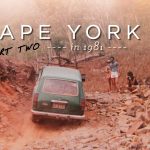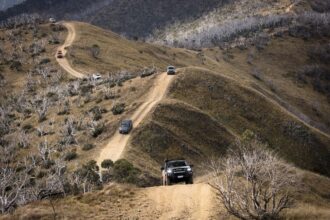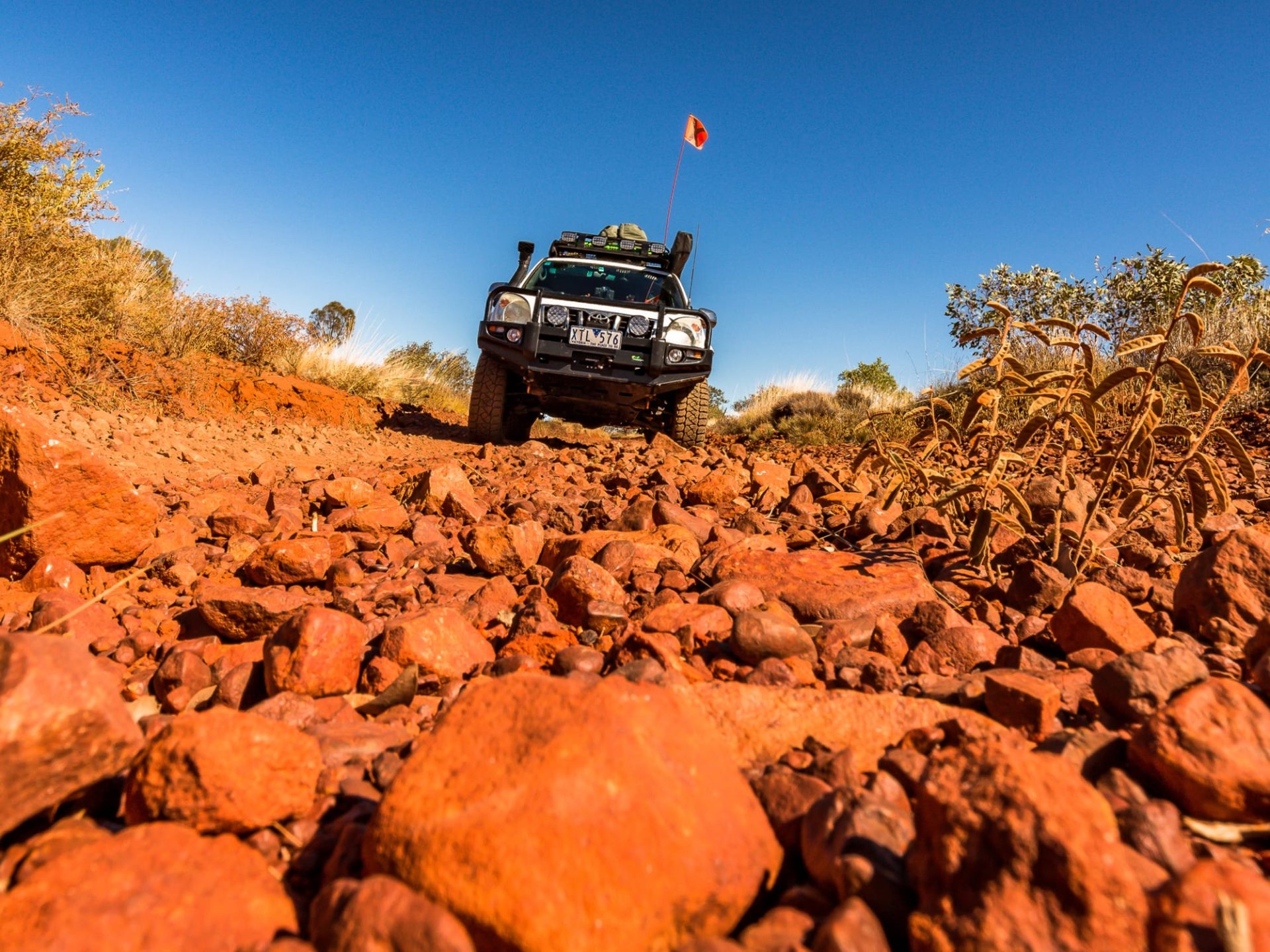There’s way more to Carnarvon National Park than just the gorge.
What do a 17th-century Baroque painter and a New South Wales Surveyor-General have in common? They both loved the dramatic landscapes that this section of the Carnarvon National Park has in spades. When Major Thomas Mitchell stumbled across the crystal waters of the Nogoa River in July 1846, he named some features in the area after the painter Salvator Rosa. When I saw the road sign I knew I was on the right track. I was on the Wilderness Way, a rough and ready loop road that traverses deep gorges with immense cliff faces dominating the landscape. You will be awestruck by the rugged beauty and vistas of tangled ranges and unique flora.
I had departed Tambo with the obligatory Tambo Teddy, following the Dawson Development Road 43km north until the turnoff for Springsure. The warning sign was prominent (‘Rough Surface’) and with the road turning to gravel, it felt great to be back on this terrain again. After 90km I reached where the Wilderness Way diverts off the Dawson Development Road at the junction with the Cungelella Road. There is a rest stop here with a rainwater tank and shelter, perfect for lunch or a cuppa before taking the turnoff and following the Wilderness Way along Cungelella Road. The road becomes more of a station track for a while, and water was still filling the culverts on the sides of the track. Once the land opens up, the track widens and you are met with the vista of the spectacular escarpments rising dramatically from the valley floor. My excitement grew as I approached. Once you’ve covered 24km, take the track to the left at the fork and follow the signs to Salvator Rosa. Bottle trees appear in the paddocks and Santa Gertrudis cattle graze freely on fresh growth from the recent rains.
You slowly pass Cungelella Station (make sure you go slow to keep the dust down), then turn right onto Salvator Rosa Road. The track turns to black soil as it leads you 18km to the Nogoa River campground. It’s a large open space with a couple of communal fire pits, some tables, a clean eco-toilet and a rainwater tank with non-potable water. This is the only place that camping is allowed in this section of the Park. I quickly set up before enjoying a night around the campfire with a couple of intrepid travellers.
Next morning after bacon and eggs for breakfast it was time to head off on the 4WD-only self-drive tour of the Park. The first challenge was to successfully navigate the crossing of the Nogoa River. With a sandy base and a well-placed rock, the crossing was simple this time. Rains from further afield can cause sudden flash floods so care must be taken. Park Rangers have buried planks of wood in the northern entry/exit point to reduce the erosion caused by water runoff from your 4X4. Most of Salvator Rosa is covered with Eucalypt woodland and open forest whilst shallow soils on the ridge-tops support forests of gum-topped Ironbark. The exposed rocky outcrops are scattered with black Cypress pines. In spring the wild flowers light up the landscape.
Spyglass Peak was my first stop. An 800m return track leads from the small car park, past vivid orange-barked Yellow Jacket trees, to the base of the sandstone outcrop. This feature is named ‘Spyglass’ due to the 10-metre diameter hole near its summit. The walking trail around the base is indeterminable in places and the best place to photograph the Spyglass was just off the track before reaching the car park. I then followed the sandy track to its conclusion at Major Mitchell Springs. This permanent waterhole with its dense stands of Phragmites Australis reeds provides a safe haven for frogs and fish as well as molluscs and other freshwater invertebrates. Further downstream, the waters from Mitchell Springs seep over peat bogs before sinking into the sand and flowing underground – resurfacing as Louisa Creek at Belinda Springs.
A short walk from the springs will take you to the ‘yard site’ where Major Mitchell set up base camp in 1846 so that his party could rest, having explored the wild country to the north and north-east. All that remains of the stock yards is a few fence posts and the marks in the sandstone cliff wall where the cross posts used to be. This is a great place to enjoy a relaxing lunch with a bench perfectly placed to sit and while away the time looking out for a Heron, Reed-Warbler or Red-backed Fairy-Wren amongst the foliage. The trickle of water is soothing and the dragonflies glisten in the sun as they hover searching for food.
As you head back the way you came, Homoranthus Hill is the next port of call. A 150m walk takes you to the top of a sandstone outcrop and offers 360-degree views of the surrounding landscape – including excellent views of the Three Sisters and Spyglass Peak. I was amazed when I walked down to Belinda Springs. I could hear the rush of water as I entered a smothering of ferns that thrive in the moist conditions. The crystal clear water of Louisa Creek was gushing over the rocks, disappearing amongst the clusters of ferns. Around four million litres of water flows daily into Louisa Creek from Major Mitchell and Belinda Springs. The junction of Louisa Creek with the Nogoa River is another top spot to spend some time. A shelter and picnic table are located at the car park and it is only a short stroll down to the river. Had the temperature been a couple of degrees higher, I would have been ripping my gear off and enjoying a soak in the crystal waters. As it was, all I did was whip out the camera and take a few shots.
After watching the colours sharpening in the deeply-eroded sandstone escarpments as the sun set, I reminisced about the number of amazing sights I had enjoyed in Carnarvon National Park. I also remembered the number of wonderful fellow travellers that I had met who also appreciated the wonders of this National Park. All I can say is, put the remote sections of Carnarvon National Park on your bucket list… it’s not all about the Gorge.
THE PEOPLE YOU MEET
I happened across this unique vehicle that had made a mockery of warnings telling you that Salvator Rosa is accessible by 4WD vehicles only. It was owned by a gentleman named Tony, who built the accommodation section himself whilst living in Tasmania. At 73, this ex-shearer was five years into travelling around Australia. He loves camping in National Parks and survives quite easily, completely off the grid. He loves to explore the Parks by foot, happily trekking for hours… sometimes making his own tracks as he searches for hidden beauty.
Now a vegetarian, he’s content dining on bread, cheese, fresh vegetables and eggs. There’s no fridge inside his home (“It used too much battery power”) but he does have a small wood heater to warm him up when it’s cold and to boil the billy for a cup of tea. “Toasting the bread makes it last longer,” Tony told me as he enjoyed his cheese and tomato on toast for dinner in front of a warming fire. A laptop, DVD player and radio are almost as precious to Tony as his vehicle. He watches movies or listens to opera during the night, only sleeping when feeling tired. Two small solar panels recharge the car batteries each day to allow him the comfort of his electronic toys.
A quiet, unassuming man, Tony finds whatever water he can to drink; even drinking from cattle water points when necessary. He enjoys the solitary life he leads but also enjoys chatting to fellow campers around a campfire as the evening turns to night. As much as I would have loved to see inside Tony’s home and take a picture or two, I knew that he wouldn’t have enjoyed the intrusion or the attention. Even a photograph of Tony and his vehicle was knocked back… so all I can show you is Tony’s home, without the man himself. The abode is constructed with cement sheeting, chicken wire and wood paneling, and Tony carries everything he needs down all sorts of roads and tracks. He has a secret as to how he drives; but it wasn’t passed on. Only twice has he ever been pulled over – both times for a look more than for an infringement.
If you see Tony in your travels, stop and say g’day. He appreciates a chat and if you can drive him to see a site or to collect some water he will appreciate you even more. A true Aussie Gentleman is Tony, and I feel privileged to have met him.
DESTINATION DETAILS
Getting there:
Salvator Rosa lies between Springsure and Tambo. From Springsure, head 113km west along Dawson Development Road to the Wilderness Way turnoff. From Tambo, head 42km north on the Dawson Development Road then turn east towards Springsure and drive 90km to the Salvator Rosa turnoff. At the turnoff, drive south for 50km via ‘Cungelella’ to the Park boundary and a further 4km to the campsite. Conventional access to the camping area is possible but 4WD is essential inside the Park. The access roads become impassable after rain. The nearest fuel is at Springsure or Tambo.
Where to stay:
Bush camp at the Nogoa River camping area, book online for $6.15 per person per night or $24.60 per family per night. You will need to be totally self-sufficient and carry plenty of food, fuel and water. Take a fuel stove for cooking. Boil the creek water before drinking. Take your rubbish with you.
Best time to visit:
Between April and September, as the summers can be extremely hot.
GPS route details
Nogoa River Campground – 24°48’08”S 147°12’10”E
Spyglass Peak – 24°49’02”S 147°11’48”E
Louisa Creek Junction – 24°49’28”S 147°11’33”E
Homoranthus Hill – 24°49’35”S 147°11’56”E
Major Mitchell Springs – 24°51’29”S 147°11’28”E









